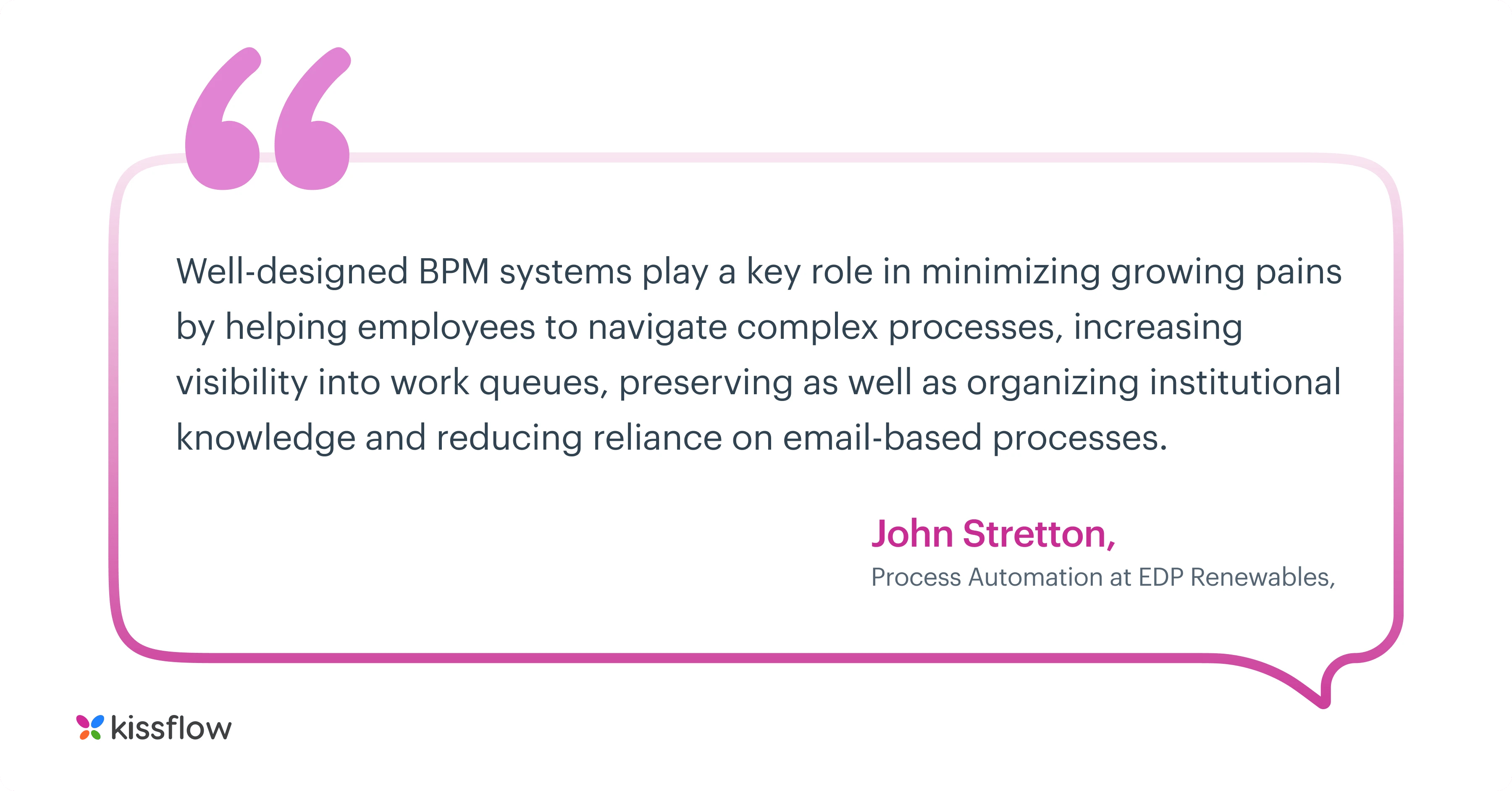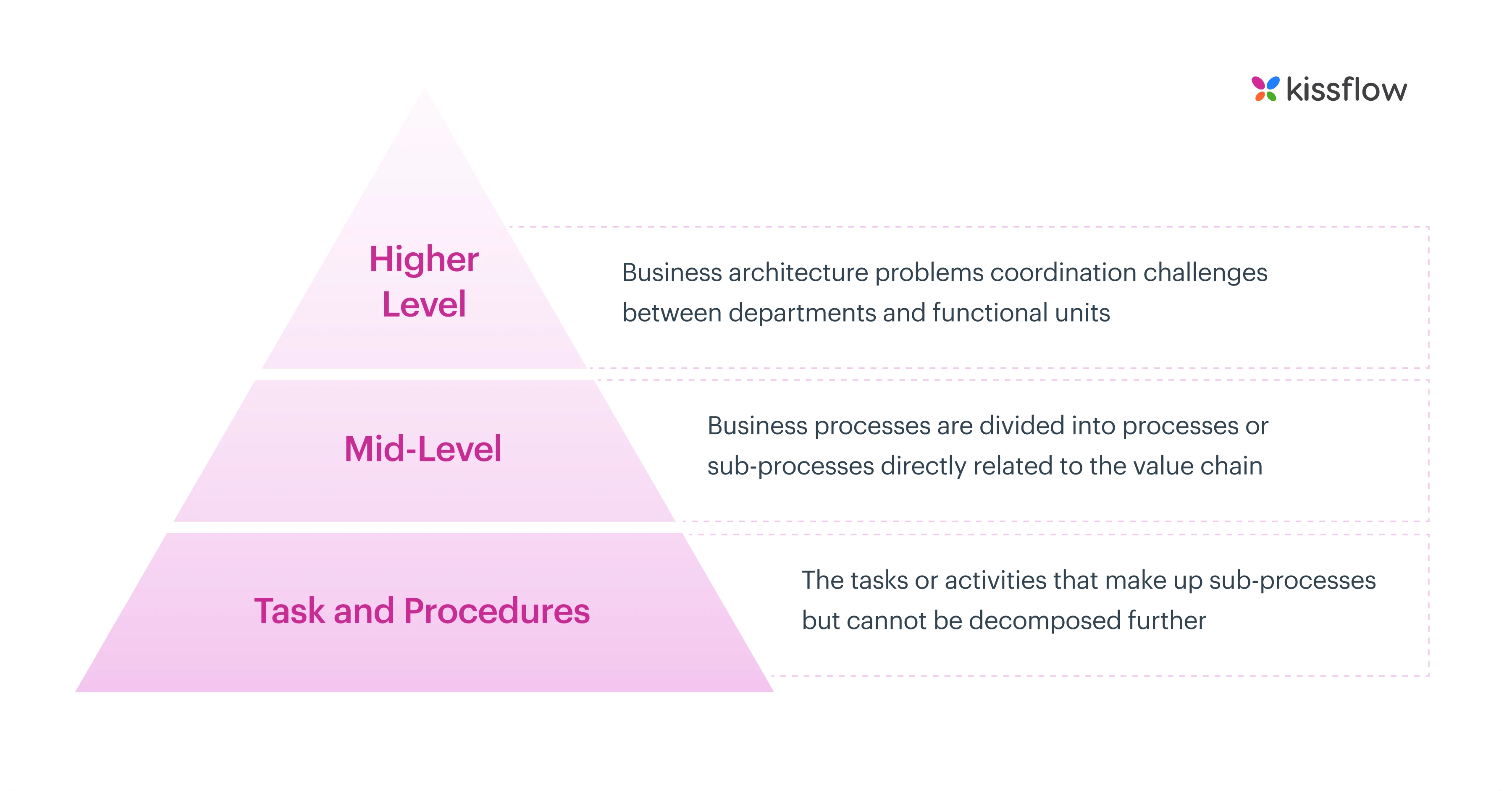
- >
- BPM Software >
- Business Processes Hierarchy - The Ultimate Guide
Business Processes Hierarchy - The Ultimate Guide
Team Kissflow
Updated on 22 Mar 2024 • 4 min read
To survive and stay relevant, enterprises must ensure their internal business processes provide value to the overall business outcomes
CIOs need to prioritize eliminating non-valuable processes, and updating and optimizing the remaining processes as part of their digital transformation strategy.
But how to identify processes that are currently providing value to the business? Or if they align with the organization’s overall strategic goals and needs?
The answer is business process hierarchy.
Effective process management begins with a well-defined process hierarchy. Linking processes to a clear and ordered hierarchy adds significant value by providing granular detail on who undertakes the process to ensure consistency and coherence.
A process hierarchy helps you prioritize, improve, and optimize the most critical processes.
Did you know that only 4%[1] of organizations measure and manage their processes, a very crucial business activity? To survive, your business must ensure processes provide value to its overall business outcomes, something possible if you're tracking your processes. Effective management involves eliminating non-valuable processes, and updating and optimizing the remaining processes.
Process improvement focuses on performing processes more efficiently, delivering them on time and within the expected cost. But how does your organization know if its processes are providing value? Or if they align with the organization’s strategic goals and needs?
The answer is business process hierarchy.
Effective process management begins with a well-defined process hierarchy. Linking processes to a clear and ordered hierarchy adds significant value by providing granular detail on who undertakes the process while ensuring internal consistency and coherence.
But, fewer than 20%[2] of your processes are worth the effort and significantly impact your competitive edge. Using a process hierarchy helps you prioritize, improve and optimize the most critical processes.
Introduction to Business Process Hierarchy
Process hierarchy helps organizations identify and track the internal improvement areas to create value out of every process. Businesses can also spot all key interactions influencing customer perception of the organization. Aggregating business processes in a hierarchy helps companies measure business outcomes against overall organizational goals.
Business process hierarchy breaks large processes into smaller chunks, offering a logical context in which each process can function, be measured, and analyzed for improvement. A hierarchy that best suits your business structure traces every process and pinpoints its contribution to your strategic business goals.

What is a Business Process Hierarchy?
A process hierarchy divides core business processes into lower-level processes with detailed tasks or activities and graphically represents them. It shows the course of process breakdown from complex business processes, sub-processes, and process segments, to more detailed lower-level steps.
All processes from a complex process are placed on the same level, with each process showing “how work gets done.”
Process hierarchy ensures processes are defined at the right complexity level, and granularity, and illustrates how all processes collectively fit in. It allows businesses to break down processes until they reach a level where further decomposition is impossible, so they can pay more attention to individual processes and perfect their work.
Businesses have different ways of ordering their process levels, but the size of the organization determines the number of levels in the hierarchy and the details included in each level. How the business is structured–by value chain, value stream, capability, or function–also influences the hierarchy.
Levels of the business process hierarchy

Process hierarchy is typically divided into three specific levels, with each providing more granularity and detail than the level preceding it.
1. Higher level
It's the topmost level, commonly associated with business architecture problems or coordination challenges between departments and functional units. At this level is the value chain which represents a major business line. Here, the business focuses on aligning inputs with outputs.
2. Mid-level
Depending on the nature of the organization and the complexity of business processes, here business processes are divided into processes or sub-processes directly related to the value chain. Mid-level hierarchy addresses departmental difficulties requiring simplification, task automation, or sequence rearrangement.
3. Task and procedures
It contains detailed information on the tasks or activities that make up sub-processes but cannot be decomposed further. They often require a detailed task analysis and are captured as day-to-day activities or work instructions. They include job descriptions, specific business rules, and user, or system responsibilities.
Benefits of having a process hierarchy
-
Provides knowledge on how tasks flow in the company, increasing understanding of an organization’s business processes, employee accountability, and pinpointing the people responsible for key decisions.
-
Since it follows an abstract-to-concrete principle, it acts as the documentation structure for process management.
-
Deciding and agreeing on levels of hierarchy prevents a mismatch of stakeholder expectations.
-
Helps organizations deploy resources more effectively to reduce waste, deliver value, and meet corporate goals.
-
Increases the speed and efficiency at which employees perform their tasks, ensuring the business runs smoothly.
-
It's a systematic improvement approach that identifies current and potential processes and how they link together within the organization
How to create a Business Process Hierarchy
Creating a professional, well-defined process hierarchy is a complex and time-consuming undertaking. So, depending on your business complexity, level of enthusiasm, or the amount of time, you can hire a consultant, use predefined process hierarchies, or take ownership of the project.
Steps Involved in Creating Process Hierarchy
-
Start with your current standards and systems
-
Partner with senior management to determine critical processes
-
Prioritize critical processes
-
Assign employees responsibility for each process
-
10Determine which tools to use and which format to follow
-
Manage your process hierarchy centrally
An incredibly easy way to automate business processes
How Process Hierarchy drives Business Process Management for Businesses
When a BPM solution is implemented correctly, it boosts productivity by up to 50%[3]. It also:
- Helps organizations view and manage processes better, providing insights to optimize their business. Your company can continuously measure and improve processes incrementally across the organization.
- Creates a shared and systematic understanding of critical organizational processes and identifies a clear basis for improvement. From this, you can design processes to achieve a specific goal and increase process efficiency.
- Breaks down processes that offer comprehensive performance results useful for efficient decision-making. It eliminates the silo approach and pinpoints joint areas and common process touchpoints for improvement.
Streamline and standardize your business processes
How process improvement and process optimization influence process hierarchy
Process improvement is performed at the business process level to identify and assess inefficiencies within the organization. Robust process management and improvement begin with process hierarchy and can be adjusted to suit organizational needs.
Process hierarchy makes process improvement and optimization easier because it helps an organization view all its processes as connected. The primary goal for business process improvement activities is to strategically align processes with organizational goals and ensure all processes and tasks add value.
Process improvement requires an accurate process understanding and proper management to implement the right changes. It also requires allocating resources to the most critical processes. You can use the process hierarchy to prioritize, improve and optimize key-level processes.
Add value to your business process hierarchy with Kissflow
Creating your process hierarchy is only the first step towards improving and optimizing your business processes. It also lays the foundation for standard operating procedures and typical workflow routines. But even with that, to succeed at process management, your ultimate process hierarchy goal must be customer-specific.
Kissflow is a powerful yet simple low-code platform that allows you to identify inefficiencies in existing processes and redesign them to improve overall operational efficiency. With its visual drag-and-drop form builder, you can make process changes quickly with a few clicks. Since it's low-code, business users with little to no technical knowledge can create streamlined processes from scratch.
Get started with Kissflow to build process hierarchy and optimize critical internal processes.







